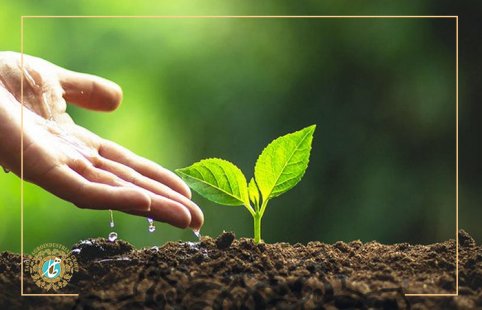
Pistachio cultivation is done successfully in different soil categories. In the pistachio-rich regions of Iran, loamy sand texture, which is a medium texture, produces the best product.
Also, in heavier soil textures such as silt loam and even clay, a suitable product has been produced. The presence of natural drains such as sand layer at a depth of more than 2 meters from the soil surface can compensate for the heaviness of the soil texture which is the most suitable soil for pistachio cultivation in terms of depth with uniform texture.
Suitable soil for pistachios
Such soils usually have good permeability, with a relatively high storage capacity of water and nutrients, along with proper ventilation for plant roots. The presence of shallow or hard layered soils causes the aerial and underground parts of the tree to remain short, thus significantly reducing its fertility and yield.
Pistachio trees do not grow well in water retention conditions. Compared to other fruit trees, the leaf stomata of pistachio trees are relatively less sensitive to drought conditions.
As a result, they can sweat a lot of water in hot and dry climates. Pistachio is a tree that adapts well to the existing conditions to survive. However, if we want to have economic production, we must irrigate it enough.
Pistachio irrigation is the special importance for the growth and development of young trees (pistachio seedlings and seeds), the quantitative and qualitative yield of mature trees and the overall growth of greenery.
In general, pistachio trees prefer deep soil with light to medium texture. The soil is layered, has hard layers to a depth of 2 meters and poor drainage, or in other words, low permeability is not very suitable for pistachio cultivation. Soils without buildings or with mass buildings are usually difficult to penetrate and are not suitable for pistachio cultivation. Excessive coarse gravel is one of the limiting factors for proper cultivation and growth of pistachios.
Soil salinity should be at least less than 8 dS / m.
The sodium uptake ratio should be at least 15. Neutral to slightly alkaline acidity may be appropriate.
High ratio of calcium to magnesium and the amount of absorbable potassium in the soil in the long run is a positive advantage for pistachio cultivation.
The amount of gypsum and lime is a limiting factor for the growth of most plants and pistachios are no exception.
Soil limitations and solutions
After identifying the soil and knowing the needs of pistachio trees in terms of soil conditions, the soil limitations for pistachio cultivation can be understood to some extent and if possible, they should be addressed, which are more likely to exist in pistachio cultivation areas. And overshadow the cultivation and growth of pistachios, along with the solution to eliminate that restriction is presented as follows.
Salinity or the presence of high soluble salts and toxicity of the elements sodium, magnesium in soils
Limitation solution
Remove very saline surface layer from the soil before planting heavy leaching based on soil type and irrigation water consumption
Use of gypsum in case of low or salinity and high exchange rate of sodium and low calcium to magnesium ratio in soil
Existence of a layer with low permeability and restricting root growth (such as petro-chibsic and petro Salic) in some soils, which makes the roots of trees, especially in old age, less able to use deep soil and in some cases restrict growth in trees and It causes proper growth and adequate productivity of pistachio trees.
Suitable climate for pistachios
The first step to establish pistachio orchards is to know the exact climatic conditions of the region and any activity should be done with the knowledge of the climatic conditions of the regions, otherwise the investment will be associated with great risk. The major damages that late cold and early spring heat cause to pistachio crop in some areas require that a careful study be done to select a suitable cultivar suitable for the regions. Spring rains, frosts, and hot, dry winds prevent inoculation, and high humidity during the growing season intensifies the onset and damage of fungal diseases. Strong winds also have an adverse effect on the young seedlings.
Water and soil conditions
Soil as the growth medium of trees and water as the flow of all nutrients (except carbon) and the most important synthetic material of plant tissue are the most basic factors in the establishment and growth of trees.
Due to the diversity of soil and water, accurate knowledge of the state of water and soil leads to a purposeful decision in choosing the location of the pistachio orchard.
Pistachio tree can be easily planted in most soils with different texture and material, so that in calcareous and saline soils it is better tolerant than other fruit trees, but in well-drained and shallow lands does not show good results.
The best soil for pistachios is sandy and loamy soils with good drainage and ventilation and low EC water and soil.
The deeper and more uniform it is, the better its growth and the higher its production.
. Establishing pistachio orchards in good water and soil is more economical and the return on investment is faster. Tolerance of pistachios in conditions of relative salinity of water and soil is not the reason for planting it in poor and saline soils, so that with poor soil and increasing salinity, yield per unit area decreases and gardens gradually become uneconomical.
In addition to high salinity of water and soil, the presence of hard layer, salinity and alkalinity of soil, the presence of a completely sandy layer under the clay layer, high level of false aquifers (drainage) or in other words high static level of limiting factors for pistachio cultivation Is.
Before constructing the garden, it is necessary to check it by water and soil experts and if the limiting factors can be removed and the conditions can be corrected, then correct it and then proceed to construct the garden, otherwise it is better to abandon the construction of the garden. .
Stages of construction of pistachio garden
1- Land preparation
The whole surface of the land is plowed deeply with a tractor, and if the soil has a hard layer or heavy texture up to a depth of 2 meters, it should be broken and made permeable with a sucker, and after plowing, it should be smoothed and leveled.
If according to the opinion of water and soil experts, the implementation of Babbler irrigation is desired, leveling with a slope of 1-2% and in drip irrigation, relative leveling is sufficient.
2- Preparing a garden plan and implementing it
In preparing the garden map, specifying the main and side streets, the location of the facilities, the place of drilling wells and the place of extraction of water storage (if necessary), plotting the farm to kill different cultivars and for planting rows of trees, the distance of rows from each other And the distance of trees on the row and the place of construction of the windbreak (if necessary) and the placement of male trees should be considered.
The most suitable distance between rows is 6-7 meters and the distance between trees is 3-4 meters, however, the distance between rows is 4-6 meters and between trees is 2-3 meters. Also, the distance between rows is less than 4 meters and the distance between trees less than 2 meters is inappropriate.
- Preparing and planting seeds in the main land:
In late March and early spring, the seeds are soaked in water for about 24 to 48 hours (preferably 24 hours), and after washing, they are disinfected using fungicides or sodium hypochlorite (bleach).
The seeds should then be placed in cloth bags that are regularly kept moist for 4 to 5 days (suitable temperature for seed germination is 20-30 ° C).
After germination, the seeds should be disinfected with a fungicide and planted in the desired location.
In fields with fresh water and soil, the germinated seeds intended for sowing are sown in the hot ground water of the main land after the soil is reaching the field capacity. If the soil texture of the field is heavy, the seeds inside each pit are covered with sand to prevent clogging. This helps the plant to grow, because not only does it provide enough oxygen to the roots of the seedlings, but it also activates the beneficial aerobic organisms in the soil. Depth of seed sowing depends on the size of the seed. The approximate planting depth is about 2 to 5 times the largest seed diameter.






User comments